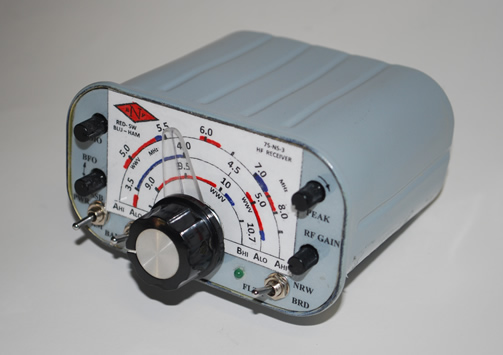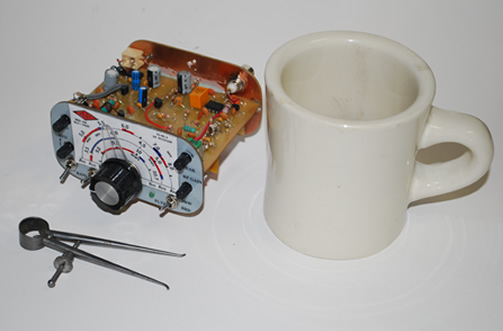National RF, of California, has introduced a new “semi-kit” receiver: the RF 75-NS-3. Here’s an excerpt from the product description page of the National RF website:
National RF’s 75-NS-3 receiver is a complete super-hetrodyne mini high frequency receiver, designed specifically for the short-wave listener, electronics enthusiast or radio amateur, who wants to use their hands and build a radio. The receiver is offered as a semi-kit in which the electronic assembly is loaded and functionally tested at the National RF facility. The customer must then go to the grocery store (yes…the grocery store!), procure a can of [Spam] lunch meat, eat it or give it to the dog, and then proceed to drill and paint the can, in order for it to become the receiver’s enclosure! […] Detailed drilling instructions and final assembly instructions are provided as part of the kit. All other parts required for completion of the receiver are provided as well. Recognizing that the finished assembly looked somewhat like the fabled Collins receiver of the ‘60s, the 75S-3, (particularly when the can is painted a light gray) National RF engineers dubbed it (with tongue firmly planted in cheek, of course) the 75-NS-3! Although we have had fun packaging this receiver in a lunch meat can, it is nothing to turn your nose at! Its performance and portability will surprise you, and it is an ideal radio to bring with you on any trip!
The receiver architecture is that of a single conversion super-hetrodyne receiver, that is capable of receiving AM, SSB, or CW. The receiver incorporates a dual gate FET as an RF amplifier with manual peaking and gain controls. A ceramic filter is used in the IF section with a front panel switch that controls a broad or narrow IF response. Other front panel controls include audio drive, BFO setting, and a band switch for the HF bands. The 75-NS-3 has internal receive frequency coils that are switched at the front and rear panels. The frequency range of the receiver, over three band set positions, is 3.5 through 12 MHz. This allows reception of several international short-wave bands, the 80, 60, 40, and 30 meter amateur radio bands, and of course, WWV time and frequency standard stations at 5 and 10 MHz.
For those who simply want a lower cost receiver to monitor the shortwave frequencies, National RF offers two variants of the original receiver: the 75-NS-1 and the 75-NS-2. Both are based on the design and circuit of the 75-NS-3, but do not have the band switching and frequency range of the 75-NS-3 receiver. The 75-NS-1 covers between 3 and 6 MHz, including the 80 and 60 meter amateur band. The 75-NS-2 covers between 6 and 12 MHz, including the 40 and 30 meter amateur bands. Both units have the fixed ceramic resonator band width set for about 6 KHz. And, of course, they are both designed to fit in the tasty potted meat can!! All other specifications presented apply to both of these models as well.
Pricing of the 75-NS-x versions:
- Type 75-NS-1 Mini HF Receiver Semi-kit (covers 3 to 6 MHz) $189.95
- Type 75-NS-2 Mini HF Receiver Semi-kit (6 to 12 MHz) $189.95
- Type 75-NS-3 Mini HF Receiver Semi-kit (band switched from 3.5 through 12 MHz in three switched positions) $269.95
- Shipping and Handling to within the US $10.00 each



The proverbial spam can has a lot to be said for it as an enclosure. Although I have not used this one, I made lots of devices with metal snap lid containers. Paint cans for RF loads, Galvanized trash can vhf notch filters ,fruitcake tins for radios, Altoids tins for power converters, Sucrets box radios. Ammo box portable battery power supply. baking tin radio chassis, cookie tins as sheet aluminum stock. perfume bottle antenna insulators. Has anyone out there done some innovative fabrication?
What’s odd is that there re cheap kits out there.
Ramsey and Vectronics (now owned by MFJ) both have simple receivers that are priced reasonably. These aren’t great receivers, but a chance to build something, which will give results.
People need that, being able to enjoy building something that isn’t really expensive, but which isn’t absolutely basic either.
And there are still a few kits out there which offer something different, but there the higher price is warranted. You shouldn’t be paying a very premium price for a basic kit.
Michael
Kind of interesting to see how radio kits meant to cut costs and make radio equipment more affordable reached some kind of break-even point somewhere around the end of the Heathkit era, and continued on the other end of the graph to be a rather costly past-time activity, with super-simple kits doing much less while costing way more than some off-the-shelf radio. I mean, c’mon, TRF receivers (like the new Heathkit) and single-superhets like this one at prices reaching far into the 3-digit range? I wonder if there’s really a demand for kits like those?
I was really interested in it as a possible purchase when reading the article until I got to the price. I’m with with DX Listener, they should at least give you the can of Spam at that price. 🙂
Not at those prices 🙁
link seems broke?
Click here to view on the National RF website.
Fixed! Thanks.
What a novel idea, and the retro-style look reminds one of receivers from the ’50’s. And to boot, Spam is very tasty